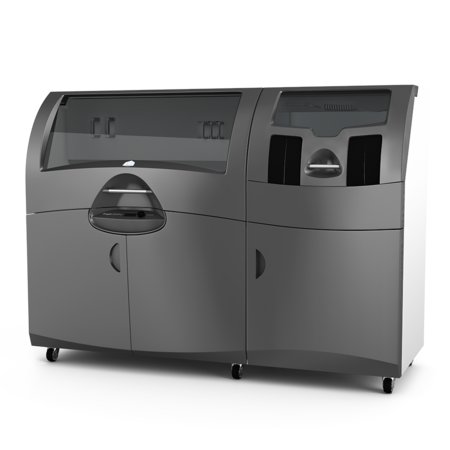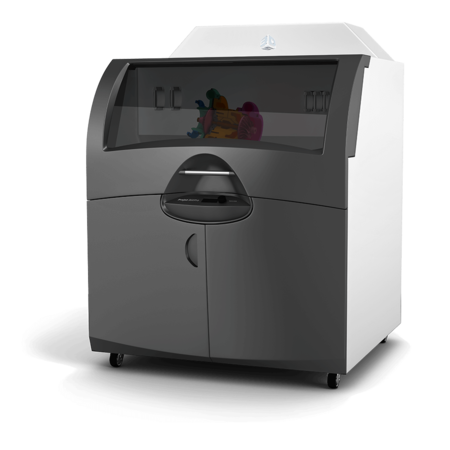The ProJet CJP's unique 3D printing technology came straight out of the Massachusetts Institute of Technology (MIT), but some of the most compelling best practices for 3D printing are coming from the other side of the world, specifically the University of Stellenbosch in South Africa.
The 25,000-student institution is an established research leader, with two of South Africa's six Department of Science and Technology Centres of Excellence on campus. More than 200 staff members are National Research Foundation-rated researchers, the second-highest number in the country. Major projects are under way in biotech, solar power, polymers, agriculture, medicine, and satellites to name a few.
Since 3D printing's full potential is yet to be grasped, the university is developing an exhaustively documented "capability profile" of the technology. Industrial Engineering Professor Dimitri Dimitrov, head of the university's Laboratory for Rapid Product Development (LRPD), is leading the university's effort to explore 3D printing's value in manufacturing, prototyping, architecture and medicine.
The research will provide the South African industry with objective data on which to base manufacturing decisions. Simultaneously, the work is exposing students across multiple disciplines, not just engineering, to advanced technologies.
"Companies that want to integrate 3D printing into their product development, prototyping and manufacturing processes still lack reliable information regarding its potential," Dimitrov says. "Our goal is to answer questions so that users can better control their processes and results. We want users, including our students, to know exactly what to expect when they use a 3D printer."
More than 800 Projects, Documented Results
To execute the research, the university's Department of Industrial Engineering standardized on the ColorJet Printing (CJP) technology and it's cost effective, patented inkjet-based technology because of its dramatic affordability advantage. The department opted for this technology over expensive approaches to modeling, casting and rapid prototyping. The university purchased its first CJP printer in 2000, upgraded to the ProJet CJP 360 in 2004, and has completed more than 800 separate 3D printing projects across departments and disciplines. The research is revealing exciting new applications for 3D printing, including the creation of molds and patterns for casting and for the rapid manufacturing of fully functional prototypes.
"Some companies resist rapid prototyping adoption because they perceive the technology as too 'fancy' or the materials as lacking this or that quality," says Dimitrov. "ColorJet Printing, however, has advanced 3D printing to the point where it can cost effectively provide vital strategic benefits to organizations. These benefits are seen not only in concept modeling but in the production of tooling for prototypes that organizations can use in design validation, functional testing, proof of concept trials, and pre-production design checks."
Dimitrov and his colleagues have scientifically documented this capability and the value of 3D printing with the ProJet CJP 360 in investment, sand and vacuum casting. For example, designers can build a mold for direct metal pour straight from a cad file or fabricate molds, cores, cavities, and patterns in a range of materials.
One of the most important things the University of Stellenbosch is accomplishing with 3D printing is the most subtle. Dimitrov and fellow researcher Neal de Beer have published a detailed matrix of different material combinations and their effects on accuracy, surface roughness, build volume location and time for each combination. Industry can use these findings to improve manufacturing processes.
Combining Students, Industry and High Tech
Students are getting involved in the private sector as well. Especially when university/industry partnerships involve high technology, they provide unprecedented education potential.
As part of this mission, Stellenbosch has performed 3D printing work for a nearby architectural firm. Students have created a physical model of the Durban Millennium Tower, a monument that identifies the port city of Durban, South Africa, in the same way, that the Eiffel Tower signifies Paris.
Seventy-five meters high, the one-of-a-kind edifice is "a barometer for the city," communicating fluctuations of sun, wind, and tide. The cowl revolves so that its curved front faces the wind. The central spire moves up and down to indicate the tide. A computer-driven sunscreen tracks the movement of the sun, shielding port operations workers from glare. At night, lighting colors within the cowl change according to a random algorithm driven by the tide, wind direction, and humidity.
The architect, sound space design of Cape Town, requested a model of the tower for customer presentations and other marketing purposes. Such a model is a tall order for a 3D printer since its final height exceeds the printer's build area. Also, parts must be strong and tolerances tight to enable seamless assembly of printed segments. The ProJet CJP 360 produced a striking result that has prompted other firms to request architectural models for the concept and design phases.
Meanwhile, the university's medical school is also using 3D printing. It is converting CT and MRI scans data into 3D models for academic and clinical purposes, enabling students to examine anatomy without surgery or dissection. It enables them to practice and plan skill-intensive procedures and treatments and is especially helpful for visualizing abnormalities such as tumors and birth defects. Students are working closely with a craniofacial specialist to create models of head and facial structures.
Students have also used the 3D printer to make models of products like cell phones, remote controls, underwater cameras, corkscrews, elaborate perfume models, innovative electrical plugs and the Eiffel Tower.
The scope of possible uses for 3D printing across the university is only broadening as additional educational opportunities are uncovered, according to Dimitrov. "We are very happy with our strategic decision to adopt this technology. We find it cost effective, versatile, fast and easy to operate. Given its accuracy, strength, surface finish, build speed and cost, we calculate a very good price/performance ratio for the ProJet CJP. It is paying off handsomely in teaching, learning, and business."

